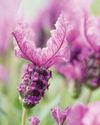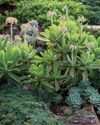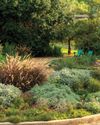Gardening is biology, revolving around the biological processes of growth and life. For millions of years, plants have thrived and grown successfully with no human intervention.

Chemical pest control and plant nutrition have become the norm over the past 80 years, though, with many negative side effects recently emerging. The good news is that new natural innovations, offering a long-term holistic alternative, are now emerging – ‘biologicals’.
A biological approach centres around nature, embracing the synergistic relationships that occur naturally to ensure survival and sustainability. As gardeners we have been taught to view bacteria as germs, fungi as diseases, and insects and weeds as pests. However, the scientific truth is that many of these critters are beneficial, even essential, to healthy plant growth and development. When there is an excess of one pest species it is often an indication that the natural balance has been disturbed and an indication of vulnerability.
Natural biological control takes place continuously, in its own unique way, within every ecosystem. Using a garden as an example, biological pest control would include everything from birds feeding on grubs to owls catching rats, to ladybirds keeping aphids under control, or parasitic wasps laying their eggs on caterpillars. Even competitor plants such as alien invasives influence the ecosystem of a garden. Finally, gardeners need to be aware that there are good pathogens – beneficial bacteria, fungi and viruses that feed on microbes and insects. There are also bacteria that are good for the soil, as probiotics are good for your stomach.
Esta historia es de la edición August 2019 de The Gardener.
Comience su prueba gratuita de Magzter GOLD de 7 días para acceder a miles de historias premium seleccionadas y a más de 9,000 revistas y periódicos.
Ya eres suscriptor ? Conectar
Esta historia es de la edición August 2019 de The Gardener.
Comience su prueba gratuita de Magzter GOLD de 7 días para acceder a miles de historias premium seleccionadas y a más de 9,000 revistas y periódicos.
Ya eres suscriptor? Conectar

FIRE AND Feathers!
On a dreary winter's day, a screen of fiery and feathery leaves puts up a fight against dullness!

GET THE ladies in!
At this time of year, early-flowering shrubs vie with each other to get the most attention. We say: Trust those with female names for frills and butterflies. They go the extra mile to flower their hearts out.

Vegetable Soups and dumplings
Vegetables make the most delicious soups and classic combinations are always a winner.

Yummy sweet potatoes for your good health
Boiled, baked or braaied, sweet potatoes (Ipomoea batatas) are a delicious and healthy winter comfort food. Just a dollop of butter, a little seasoning and you are good to go.

Pretty and functional
If cooking is your main thing, you would probably be more interested in the culinary value of the three herbs and some of their varieties we are describing.

Dried Seedheads & Pods
Autumn and winter are the best times to see what flowers produce the best seedheads that can be left on the plants to feed the birds and bugs and for harvesting for dried arrangements.

SO MANY FACES and so many choices...
Whoever associated a Cotyledon orbiculata (pig's ear) with the ear of a pig obviously did not know about all the varieties and cultivars this species in the genus Cotyledon has.

COLOURFUL Cold Weather WINNERS!
If it comes to a vote, these dependable shrubs will be the top candidates for prime performance in winter and in other seasons...

What makes a garden sustainable?
It is interesting to note that the United Nations defines sustainable development as: “development that meets the needs of the present without compromising the ability of future generations to meet their own needs”.

Nurturing NATURE-The Story of Kraal Garden's Transformation
Nestled within Prince Albert's rustic embrace lies a gem that is a testament to the transformative power of human vision and nature's bounty.